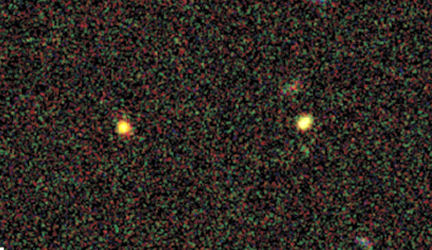In their quest to capture ever-earlier moments of cosmic history, astronomers have found some of the first galaxies, a new study suggests.

The researchers used infrared and visible-light observations to compare the properties of two previously identified sets of distant objects: about 21 galaxies viewed as they appeared about 1.2 billion years after the Big Bang and 120 galaxies that are around a billion years older.
Before using the younger group to test ideas about the first stages of galaxy evolution, the astronomers needed to show that those galaxies were truly immature. Over the past few years, researchers have found several galaxies in the young universe that nevertheless have old populations of stars (SN: 10/8/05, p. 235).
The younger galaxies indeed show hallmarks of being in their first blush of youth, concludes Malcolm Bremer of the University of Bristol in England. Compared with the older, well-studied group, the 21 younger galaxies turned out, on average, to be smaller, have less of the elements heavier than helium, and have much less mass invested in stars. They were also making stars 10 times as rapidly. In fact, the 21 galaxies are converting gas into stars at a furious rate, each producing the equivalent of 500 new suns a year.
Most of the stars in the younger galaxies, the study found, are about one-third the age of stars in the older group.
Bremer reported his team’s findings this week at the Royal Astronomical Society’s annual National Astronomy Meeting in Preston, England. The group also describes its work in the May Monthly Notices of the Royal Astronomical Society.
The report is “the first explicit demonstration I am aware of that we are seeing a step closer back toward the truly first galaxies,” comments theorist Zoltan Haiman of Columbia University.
Bremer’s team has captured the galaxies “at a special time,” soon after star formation in those galaxies had switched on, says astronomer Richard Ellis of the California Institute of Technology in Pasadena.
The findings are in accord with the accepted model of galaxy formation, in which galaxies start out small and then grow by merging to form the massive galaxies, such as the Milky Way, seen in the universe today, say Bremer and his colleagues.
The combination of infrared observations—using NASA’s Spitzer Space Telescope—and visible-light studies was critical to obtaining a complete census of the stars and stellar masses in the galaxies, notes Bremer. Visible-light observations reveal young, massive stars, while infrared detections disclose cooler, lower-mass stars.
Astronomers haven’t yet come to the end of the line in their quest for the first galaxies, cautions astronomer Garth Illingworth of the University of California, Santa Cruz. Bremer’s team may be viewing those 21 galaxies bursting into life, he notes, but he and others have observed a few other galaxies that date to even earlier times and are similarly immature.
To verify the new study of the early galaxies, astronomers will need to take spectra to confirm the age estimates of the stars and to measure the abundances of chemical elements, suggests Robert Kennicutt of the University of Cambridge in England. That work may require the Hubble Space Telescope’s proposed successor, the infrared James Webb Space Telescope, he notes.







